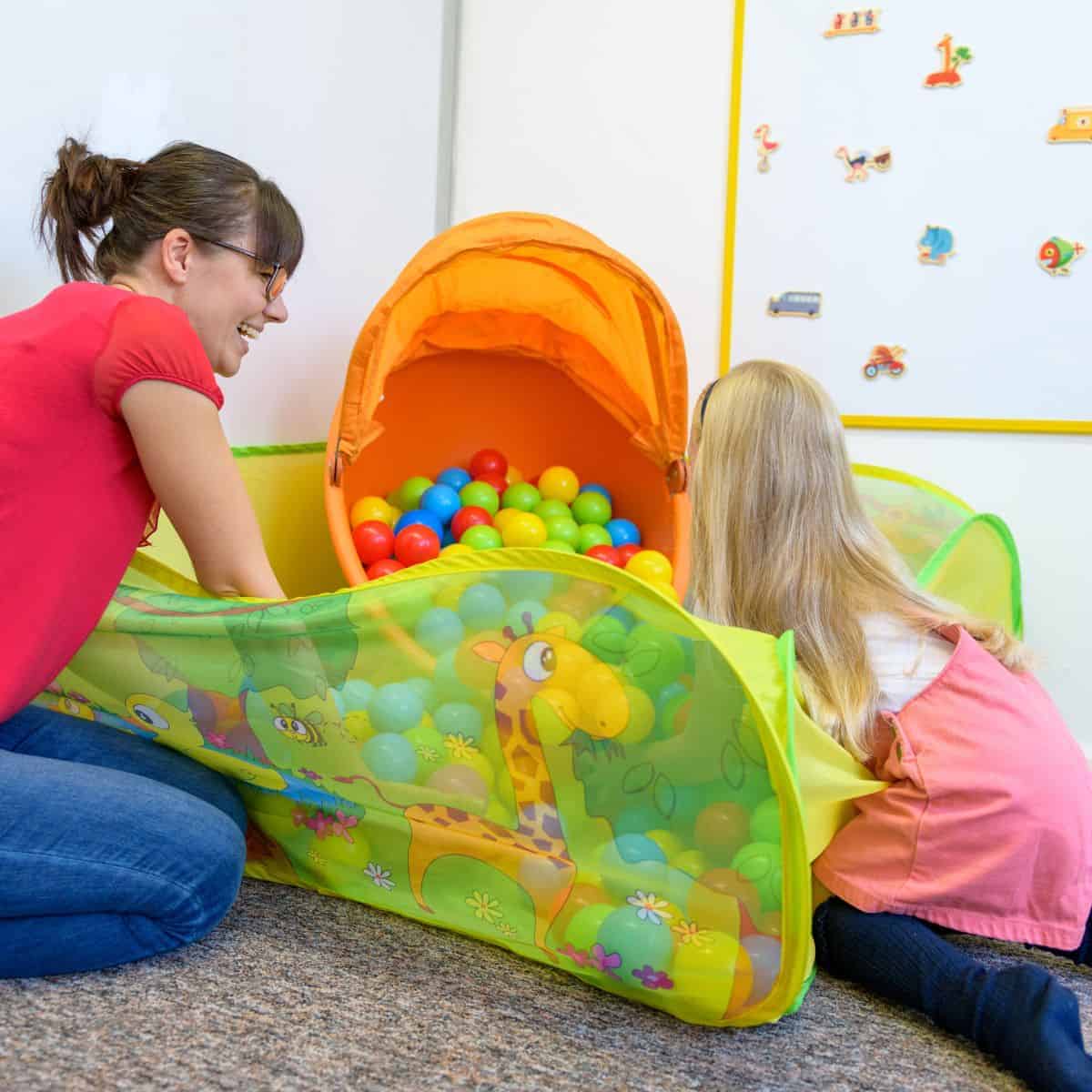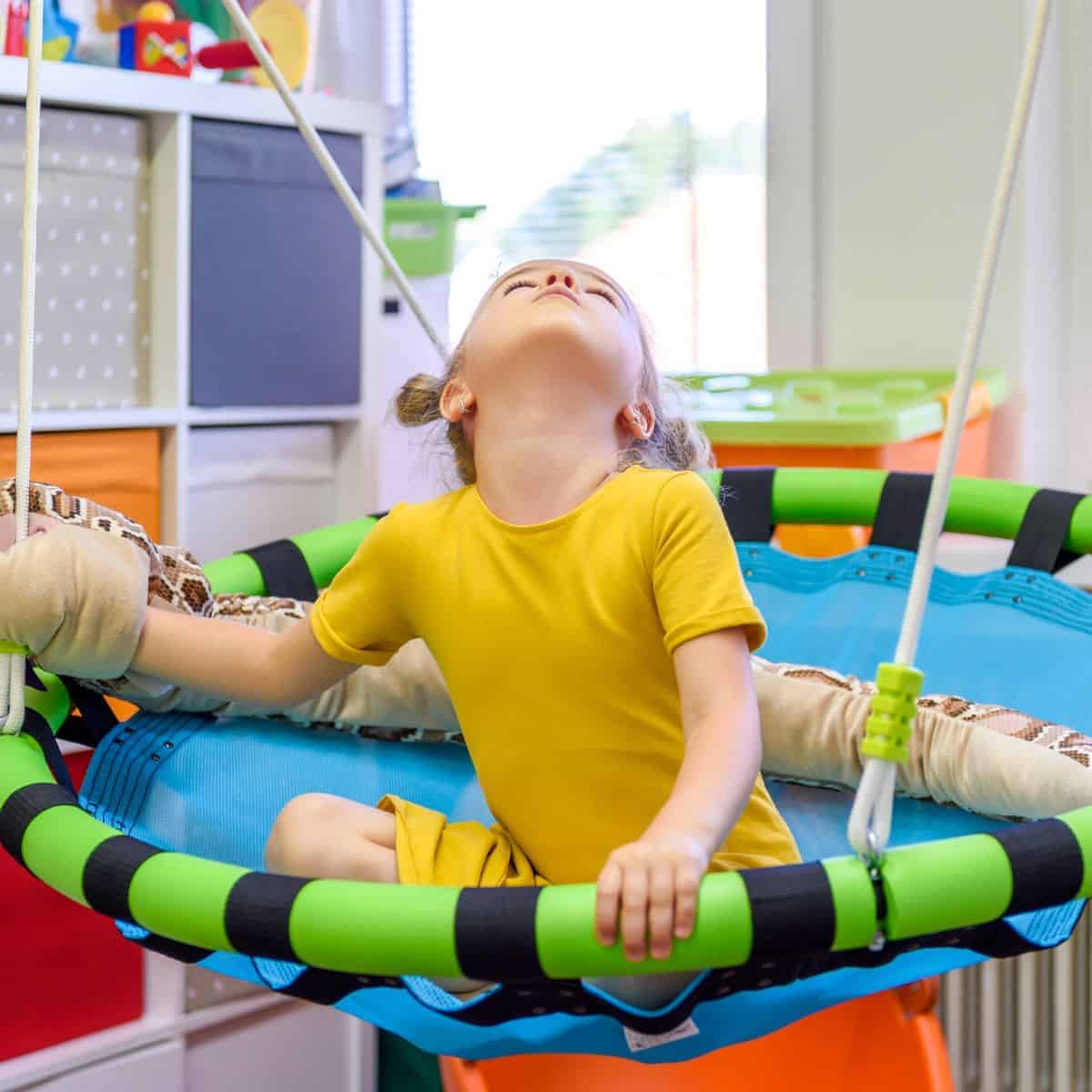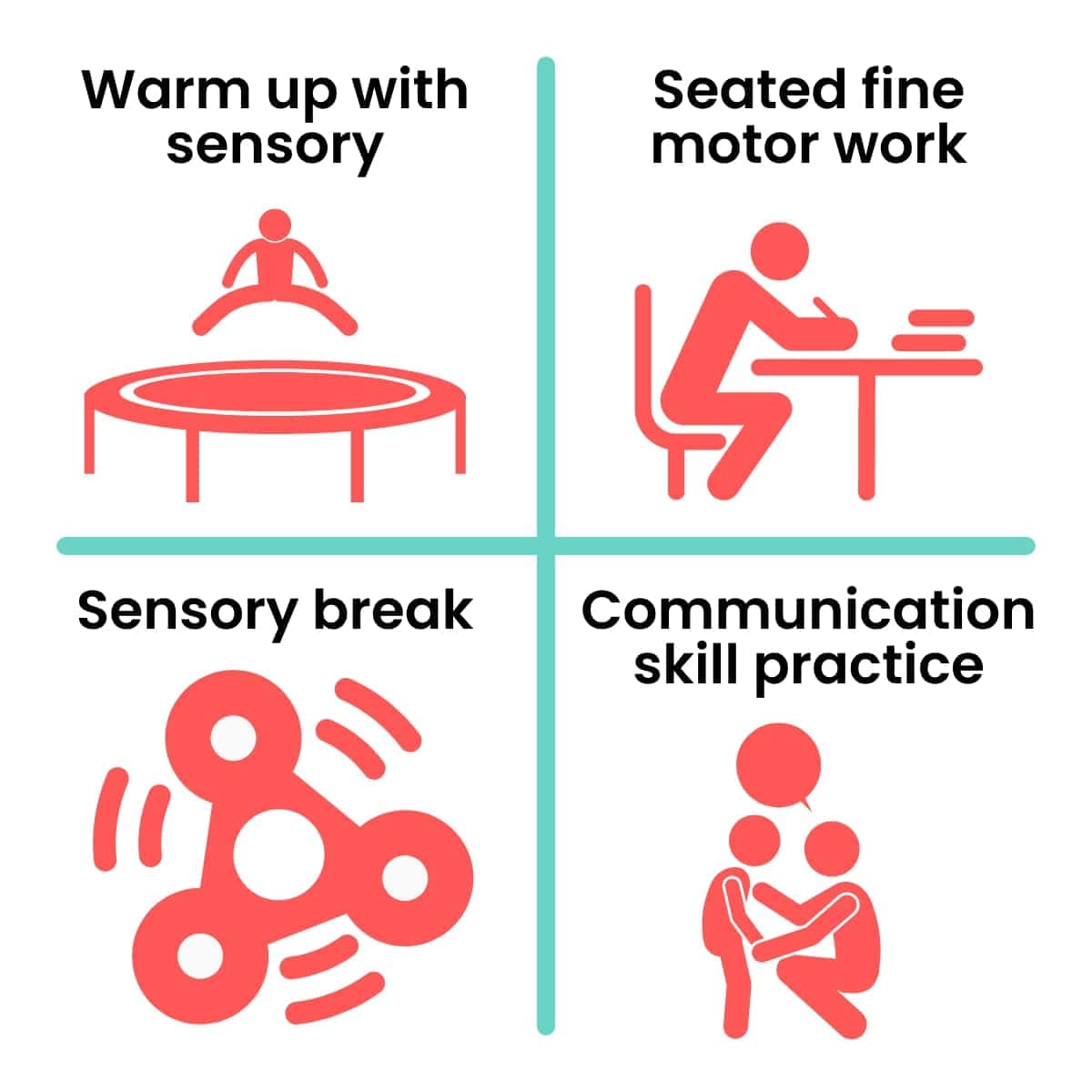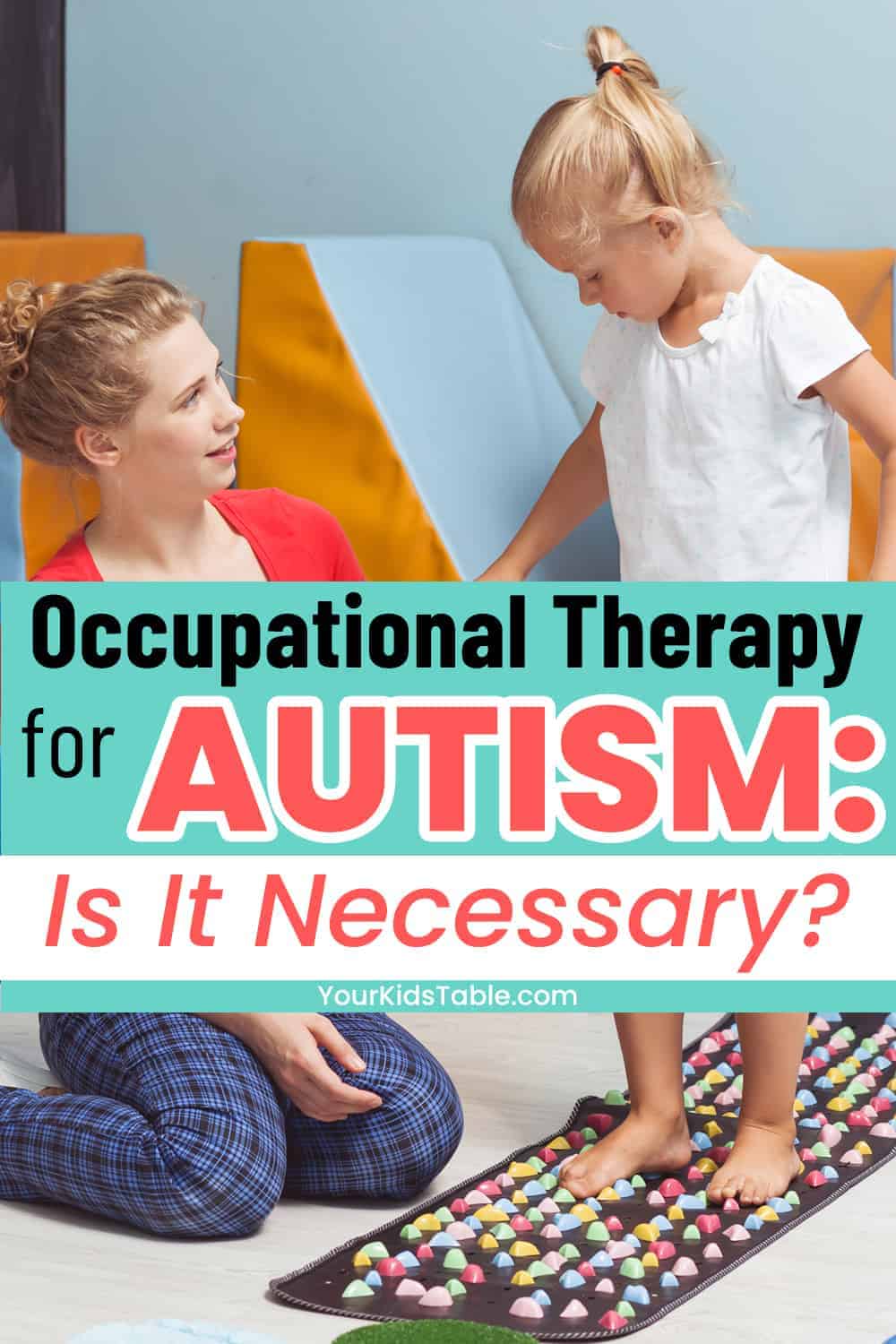Occupational therapy for Autism is often recommended when a child is first diagnosed. Learn how OT can help your child with autism and what to expect!
An autism spectrum disorder (ASD) diagnosis can come with a lot of unknowns and might even feel overwhelming when your doctor recommends interventions like occupational therapy, behavioral therapy (ABA), speech therapy, physical therapy or others.
The good news is that the number of resources for autism have drastically increased over the years, with a more comprehensive understanding of the diagnosis being made available to the general public.
Even better, there has been a big push for advocacy from people with autism themselves, along with adults with autism, which is a huge step in the right direction as you navigate autism yourself or with a child, family member, or loved one.
What is Autism Spectrum Disorder?
Autism spectrum disorder is a developmental disability caused by differences in the brain. These differences can impact behavior, cognition, sensory processing, social relationships, communication abilities, and independence.
These abilities vary greatly from person to person, making each person with autism unique, just like those without.
ASD occurs across all racial, ethnic, and socioeconomic groups. It is more than 4 times more common among boys than girls.
As a pediatric occupational therapist who has worked with many autistic people over the years, I wanted to make a resource specifically for occupational therapy for autism, including what to expect, how to find services, and how occupational therapy (OT) can help with autism.
Before we talk about why occupational therapy is helpful for kids with autism and is even considered the best intervention by some professionals, we should first cover what exactly OT works on.
What is Occupational Therapy?
The term “occupational therapy” can be confusing because of the broad range of topics that OT addresses. Not to mention the name “occupational” throwing people off when it comes to kids.
Hint: an OT’s purpose isn’t necessarily to get your child a job!
OT is a huge umbrella that covers any area of daily life or daily routines that might be difficult for a person.
These areas are called “activities of daily living” or ADLs and include factors caused by physical, social skills, mental, cognitive, sensory, behavioral, independence, and more!
Occupational therapy, according to the American Occupational Therapy Association,
“uses everyday activities (occupations) to promote health, well-being, and your ability to participate in the important activities in your life. This includes any meaningful activity that a person wants to accomplish, including taking care of yourself and your family, working, volunteering, going to school, etc.”
You’ll find OT’s working with every age range from babies in the NICU to elderly, and a variety of settings from schools to mental health clinics to hospitals.

Occupational Therapy for Autism: How does OT Help?
When OT’s work with kids it’s often to help them achieve the highest level of independence for age appropriate skills related to fine motor skills, sensory processing, daily living skills (brushing teeth, getting dressed, eating, etc.), and even attention.
This is a wide range of areas, which is why it can get confusing what occupational therapy is for. Let’s break down these areas in more detail:
- Gross motor skills, fine motor skills, and the use of their hands
-
- Balance, coordination, and strength
-
- Handwriting
-
- Feeding self
-
- Play with hands
- Sensory processing difficulties including sensory seeking behavior and sensory avoidance along with helping sensory dysregulation.
*Learn more about the sensory systems here.
- Primitive reflexes affecting developmental skills in babies, toddlers, and older kids
- Picky eating habits
*Learn more about picky eating help here
- Social emotional skills and self regulation
- Independence and age-expected self help skills like:
- Attention and cognition skills including executive function skills
- Behavior that affects things like being out in public and school such as:
-
-
- Repetitive behaviors
-
-
-
- Avoidance of tasks
-
-
-
- Rigidity to change
-
-
- Trouble with transitions
These areas can be a challenge to a child in any environment or context, from home, learning, play, and hobbies.
As you can see, this covers everything that makes up your child’s daily activities and routine!
If your head is spinning imagining how an OT can address all these different areas, I’ll walk you through the process and an example of an occupational therapy session in the next section…
How to Get an Occupational Therapy Evaluation for Your Child
The first step to getting OT for your autistic child, is scheduling an OT evaluation. If you’ve been referred to OT by a doctor or other clinician they’ll likely have a recommendation.
Often this is through a private clinic or an outpatient facility connected to a children’s hospital. If you’re seeking an evaluation on your own, which is totally appropriate, you can google “pediatric occupational therapy near me” to find a list of options.
You’ll want to check with your insurance to find out what will be covered, with an autism diagnosis though your child will likely qualify for an evaluation and treatment.
Although many clinics have private pay options
However, if your child is under 3 and you live in the United States, your child will likely qualify for free in-home services from an OT through your state’s Early Intervention program.
These services do continue from 3 to 5, but may be provided in a preschool setting only, depending on your state’s laws.
This is a list of what’s provided for each state.
Once your child is enrolled in kindergarten through the time they graduate you can request an OT evaluation through your school district (again, if you live in the states).
This evaluation is at the cost of the school district and if OT services are recommended they will be held at school.

How Occupational Therapy For Autism Treatment Begins
Once you’ve scheduled your occupational therapy evaluation for autism, a licensed therapist will meet with you and your child and use a combination of standardized testing, skilled observation, and your personal goals and concerns to come up with a plan of care to work on.
This all, of course, will be individualized to your child’s abilities, age, and willingness to participate.
A good OT will ultimately focus on what is important to you and your child, with guidance to put together a collaborative treatment plan.
So, for example, if sensory processing is a difficult area for your child, sensory integration therapy will be considered a major part of their time in OT. If fine motor skills need work, this will be a focus, and so on.
Once an area is identified, the occupational therapist will then create a plan that uses a variety of strategies to address that area and hopefully see improvement.
Depending on the goal, intervention will begin, and progress will be determined over time based on your child’s ability to respond to it.
After the evaluation, you should expect to have a detailed report of all the OT’s findings and results of the formal assessment. This should include a recommendation of how often your child will receive OT.
Most commonly, kids with autism have an OT session 1-2 times a week for 30 to 60 minutes. You will likely also receive recommended goals which will guide what the OT works on in each session.
However, in some settings, the OT and parent create these together in an additional meeting after the evaluation and before services begin.
When treatment sessions begin, the OT will use any of the follow strategies for addressing the goals that have been created based on their needs:
- Teaching new skills or working to improve underdeveloped skills from developmental delays, injury, or regression.
- Compensation strategies including accommodations to the task or environment, or adaptive equipment to complete the task in a different way.
- Personal or caregiver training and education for how to do a task safely or differently, or the availability of resources or appropriate referrals.
- Practice in simulated environments to build social interaction skills and work in response to that environment.
- Changes in routine or expectations of the task to take away the barrier altogether.
Basically the OT will help your child overcome the challenges that are affecting their everyday life. Sometimes this is through working on a skill, but sometimes it’s through using a hack to make it more simple for them.
Ideally, you should have some “homework” to carry over what the OT is working on, and the OT is also setting up mock situations to practice what they’re learning in the clinic too!
Example of an OT Session for Autism
Let’s say your child starts occupational therapy with the following four goals:
-
- Decrease sensory seeking behavior such as constant chewing on non-food items, head banging, and inability to keep hands to self with peers.
- Build fine motor skills for handwriting and completing clothing fasteners for dressing independently.
- Learn 3 coping skills as alternatives to screaming, meltdowns, and task refusal when angry, frustrated, or sad.
- Appropriately follow a 1-step direction when prompted by mom or dad.
With these goals as the focus, an hour-long OT session might look something like this:

- Warm-up (5-10 minutes): Proprioception focused obstacle course with trampoline, crawling through tunnel, and crashing onto crashpad
- Seated work at table (15-20 minutes):
- Roll play doh out on table and use cookie cutters to cut shapes to build hand strength and coordination
- Complete a simple color, cut, paste craft for direction following and hand skills
- Sensory input break (5 minutes): Chewing on a chewy tube, fidget play, or hands in a sensory bin.
- Coping and communication skills practice (5-10 minutes): Practice 5 different deep breaths, role playing and brainstorming scenarios with OT such as “if my friend takes my seat, what can I do instead of hitting them?”
- Ending (5-10 minutes): Discuss with OT how the child did in session, take home sensory information and sensory diet ideas with “homework” to try 1x per day for the next week to see how behavior improves.
The sensory activities used in this example are part of what’s called a “sensory diet,” and is a strategy that can have a big impact on kids with autism. And, it can be used at home and school, too!
Learn more about which sensory activities to use to calm your child in our free workshop here!
As you can see, the activities within the OT session target the goals the child has, but are framed in a way that is fun, age-appropriate and interest-based for the child.
This is the best part about OT- most kids LOVE it and don’t even know they’re working on important skills!
Does My Child with Autism Need Occupational Therapy?
Whether or not you choose to get occupational therapy for autism is entirely up to you, but hopefully the examples we just discussed take away some of the mystery of what a session with your child might look like.
Autistic children and adults do not always need therapy, so it really depends on your personal goals and concerns, which is why it’s important to make sure these are discussed if you do end up seeking therapy.
That said, many kids and people with autism struggle in the areas outlined above due to difficulties with sensory processing, cognitive processing ,social and emotional skills, and independence that impact daily life.
There is a big link between autism and sensory processing difficulties, so it is extremely common for this to be an area of focus.
Research shows that early intervention services including occupational therapy for autism can greatly improve a child’s development, so it is important to seek out resources if you think your child or loved one could benefit from them.
Occupational therapy interventions should be as diverse and unique as each child, so even though I’ve outlined an example above, the therapy sessions should vary depending on what is being worked on.
Remember, one size does not fit all when it comes to anyone- whether they have autism or not- so it’s important to find a therapist and plan of care that are a good fit!
Young children, older children, teens, and adults with autism may all benefit from occupational therapy services, so I encourage you to see what is available in your area if you are seeking help.
How to Get Occupational Therapy Services for Your Child
To get OT services, you have to start with an occupational therapy evaluation (see the section above).
Once you have an evaluation and the result, the therapist will have those recommendations for you and you will begin treatment at that facility.
If for some reason you can’t or don’t desire to continue with the facility when that evaluation is completed, you’ll most likely have to have another evaluation if you want to have treatment elsewhere.
Remember, if you want some personal guidance on getting started, have a conversation with your doctor who can make a referral for you to the right type of therapy based on your child’s needs.
Does Occupational Therapy Help Adults With Autism?
Because of the rise in understanding, acceptance, and resources for autism, many adults are seeking services in adulthood as well as being able to express their own personal experiences of growing up in therapies.
Occupational therapy for autistic adults can help with things like independent living, getting and being successful at jobs, social skills in hobbies and the workplace, and home management.
If you are an adult with autism and would like to get resources, you can ask your doctor for a referral to an occupational therapist who can do an evaluation and make a plan of care based on your goals and concerns.
More Help For Kids With Autism
Incredible Sensory Friendly Clothing for Kids and Adults
37 Sensory Toys for Kids, Toddlers, Autism and SPD
8 Secret Strategies for Sensory Issues with Food
34 Sensory Room Ideas to Calm Kids Down (On a Budget)
Laura Mau is a licensed occupational therapist and member of the Your Kid’s Table team. She has over 8 years of clinical experience in helping families navigate complex feeding and eating, sensory processing, and reaching developmental milestones with their children. She currently practices in Colorado and has 2 young kids of her own.
Alisha Grogan is a licensed occupational therapist and founder of Your Kid’s Table. She has over 19 years experience with expertise in sensory processing and feeding development in babies, toddlers, and children. Alisha also has 3 boys of her own at home. Learn more about her here.



Hello! I’m an occupational therapist working on school and new grad (it’s my first year working), and found myself in an unique case where one of my students (who has autism-non verbal/communicating), seems to not be benefiting from the OT services, since he declines sensory experiences even though is seeking propioceptive and vestibular stimuli constantly which affects him from paying attention to everything else and therefore participation in daily activities, it’s aggressive towards me, does not follow simple commands, declines alternative communication systems and visual schedules, and I’ve literally tried every possible way of connecting with him to form a therapeutic relationship since almost a year now. I’m looking for different specialist recommendation in various ways as to what step should I take next? Family support is absent completly and I’m basically alone in this journey. Should I discontinue services? Recommend another specialist to treat him? Any recommedation, opinion, tip is greatly welcome.
Hi Yari, being a new therapist is hard and I commend you for seeking resources and help. As fellow OTs here at YTK, believe me, we all have been there. I think this heavily depends on the age of the child and other resources available in your area. While it sounds like this child could benefit from OT, specifically sensory integration, there are definitely times when services are not appropriate for a lot of reasons. A year of working toward things with little reception is a big deal, and you are not obligated to continue pushing when progress is being made. Have you taken our free sensory integration webinar yet? If you haven’t, I highly suggest it, not just for this child, but for your practice in general. It will prompt you at the end for our paid sensory course if you choose to want more resources, which also qualifies for continuing education through AOTA, just fyi.
I hope this is helpful!
Laura
Your Kid’s Table team member
Although I’m guessing there is probably some crossover, I would love a similar article about OT and ADHD help. I felt the sample goals were especially helpful, giving me some concrete examples to consider as I explore doing OT with my twins who have ADHD.
Another suggestion might be navigating the school accommodations process with an OT, and what might be reasonable accommodations to ask for/how to initiate that evaluation.
Hi Marie, thanks for reading, and we are glad you found the examples helpful. We do not currently have a post specifically for ADHD and OT, but we do have an article on ADHD that you might find helpful. Thank you for the suggestion on accommodations process. We currently have one on early intervention services, but will add this to a list of future topics to cover. We appreciate the feedback!
Best,
Laura
Your Kid’s Table team member
This article is great, although, I don’t like that it mentions autism only as OT is great for a variety of children such as those with syndromes or sensory processing in general. I want to repost this article, but am hesitant to do so because of the fact that this is geared toward autism only.
Hi Danielle,
Thanks so much for reading along and for your feedback. This article is specifically for occupational therapy and autism, in order to address the benefits of occupational therapy for ASD and to help highlight these resources to those who need them. However, we have many other posts, webinars, and courses that address other diagnoses and populations as you mentioned, with our main focus being sensory processing and picky eating. If you search “occupational therapy” you will see some of the blog posts, and on the main menu bar you should see the topics that might be a better fit for what you’re looking for. Please let me know if you would like direction to something specific, or if you have a suggestion for a topic we haven’t covered yet. We are always looking for input on future topics that would be helpful.
Best,
Laura
Your Kid’s Table team member